Enhancing PAPR and Throughput for DFT-s-OFDM System Using FTN and IOTA Filtering
Abstract
:1. Introduction
2. Signal Model and Performance Metrics
2.1. General Waveform Framework
2.2. Performance Metrics
2.2.1. Peak-to-Average Power Ratio
2.2.2. Throughput
3. Proposed IOTA-Based FTN-DFT-s-OFDM Waveform Design
3.1. Transmission Waveform Design
3.1.1. DFT Spreading
3.1.2. FTN Signaling
3.1.3. IOTA Filter Design
3.2. Receiver Design
4. Simulation Results and Analysis
4.1. PAPR
4.2. BER
4.3. Throughput
5. Conclusions
Author Contributions
Funding
Institutional Review Board Statement
Informed Consent Statement
Data Availability Statement
Conflicts of Interest
Abbreviations
| OFDM | Orthogonal frequency division multiplexing |
| DFT | Discrete Fourier transformation |
| DFT-s | Discrete Fourier transformation spreading |
| ISI | Inter-symbol interference |
| ICI | Inter-channel interference |
| FTN | Faster-than-Nyquist |
| IOTA | Isotropic orthogonal transform algorithm |
| PAPR | Peak-to-average power ratio |
| BER | Bit error rate |
| CP | Cyclic prefix |
| MCS | Modulation coding scheme |
| AWGN | Additive white Gaussian noise |
| EGF | Extended Gaussian filter |
| FDE | Frequency domain equalization |
| MMSE | Minimum mean square error |
References
- Huq, K.M.S.; Jornet, J.M.; Gerstacker, W.H.; Al-Dulaimi, A.; Zhou, Z.; Aulin, J. THz Communications for Mobile Heterogeneous Networks. THz Commun. Mob. Heterog. Netw. 2018, 56, 94–95. [Google Scholar] [CrossRef]
- Hong, W.; Choi, J.; Park, D.; Kim, M.S.; You, C.; Jung, D.; Park, J. mmWave 5G NR Cellular Handset Prototype Featuring Optically Invisible Beamforming Antenna-on-Display. IEEE Commun. Mag. 2020, 58, 54–60. [Google Scholar] [CrossRef]
- Kalfas, G.; Vagionas, C.; Antonopoulos, A.; Kartsakli, E.; Mesodiakaki, A.; Papaioannou, S.; Maniotis, P.; Vardakas, J.S.; Verikoukis, C.; Pleros, N. Next Generation Fiber-Wireless Fronthaul for 5G mmWave Networks. IEEE Commun. Mag. 2019, 57, 138–144. [Google Scholar] [CrossRef]
- Aldubaikhy, K.; Wu, W.; Zhang, N.; Cheng, N.; Shen, X. mmWave IEEE 802.11ay for 5G Fixed Wireless Access. IEEE Wirel. Commun. 2020, 27, 88–95. [Google Scholar] [CrossRef]
- Ye, N.; Li, X.; Yu, H.; Zhao, L.; Liu, W.; Hou, X. DeepNOMA: A Unified Framework for NOMA Using Deep Multi-Task Learning. IEEE Trans. Wirel. Commun. 2020, 19, 2208–2225. [Google Scholar] [CrossRef]
- Kim, J.; Choi, S.-W.; Noh, G.; Chung, H.; Kim, I. A Study on Frequency Planning of MN System for 5G Vehicular Communications. In Proceedings of the International Conference on Information and Communication Technology Convergence (ICTC), Jeju Island, Korea, 16–18 October 2019; pp. 1442–1445. [Google Scholar]
- Wang, Q.; Zhang, H.; Wang, J.-B.; Yang, F.; Li, G.Y. Joint Beamforming for Integrated Mmwave Satellite-Terrestrial Self-Backhauled Networks. IEEE Trans. Veh. Technol. 2021, 70, 9103–9117. [Google Scholar] [CrossRef]
- Torres-Carrión, R.; Torres-Carrión, H. Design and Simulation in NS-3 of Radio Access Technology with Satellite Backhaul for Implementation in Rural Exploitations. In Proceedings of the 2020 15th Iberian Conference on Information Systems and Technologies (CISTI), Sevilla, Spain, 24–27 June 2020; pp. 1–6. [Google Scholar]
- Jung, J.; Choi, M.; Goh, Y.; Chung, J.-M. Multipath TCP Control Scheme for Low Latency and High Speed XR Real-Time M & S Devices. In Proceedings of the 2022 IEEE International Conference on Consumer Electronics (ICCE), Las Vegas, NV, USA, 7–9 January 2022; pp. 1–3. [Google Scholar]
- Pan, J.; Ye, N.; Yu, H.; Hong, T.; Al-Rubaye, S.; Mumtaz, S.; Al-Dulaimi, A.; Chih-Lin, I. AI-Driven Blind Signature Classification for IoT Connectivity: A Deep Learning Approach. IEEE Trans. Wirel. Commun. 2022; early access. [Google Scholar] [CrossRef]
- Li, J.; Chen, W.; Zhang, Q. A 600W broadband doherty power amplifier with improved linearity for wireless communication system. China Commun. 2017, 2017, 21–29. [Google Scholar] [CrossRef]
- Zhang, R.; Hao, W.; Sun, G.; Yang, S. Hybrid Precoding Design for Wideband THz Massive MIMO-OFDM Systems with Beam Squint. IEEE Syst. J. 2021, 15, 3925–3928. [Google Scholar] [CrossRef]
- Ye, N.; Yu, J.; Wang, A.; Zhang, R. Help from space: Grant-free massive access for satellite-based IoT in the 6G era. Digit. Commun. Netw. 2022, 8, 215–224. [Google Scholar] [CrossRef]
- Şahin, A.; Hosseini, N.; Jamal, H.; Hoque, S.S.M.; Matolak, D.W. DFT-Spread-OFDM-Based Chirp Transmission. IEEE Commun. Lett. 2021, 25, 902–906. [Google Scholar] [CrossRef]
- Chen, X.; Cui, J.; Ni, W.; Wang, X.; Zhu, Y.; Zhang, J.; Xu, S. DFT-s-OFDM: Enabling Flexibility in Frequency Selectivity and Multiuser Diversity for 5G. IEEE Consum. Electron. Mag. 2020, 9, 15–22. [Google Scholar] [CrossRef]
- Berardinelli, G.; Pedersen, K.I.; Sorensen, T.B.; Mogensen, P. Generalized DFT-Spread-OFDM as 5G Waveform. IEEE Commun. Mag. 2016, 54, 99–105. [Google Scholar] [CrossRef]
- Sahin, A.; Yang, R.; Bala, E.; Beluri, M.C.; Olesen, R.L. Flexible DFT-S-OFDM: Solutions and Challenges. IEEE Commun. Mag. 2016, 54, 106–112. [Google Scholar] [CrossRef]
- Anderson, J.B.; Rusek, F.; Öwall, V. Faster-Than-Nyquist Signaling. Proc. IEEE 2013, 101, 1817–1830. [Google Scholar] [CrossRef]
- Wen, S.; Liu, G.; Liu, C.; Qu, H.; Tian, M.; Chen, Y. Waveform Design for High-Order QAM Faster-than-Nyquist Transmission in the Presence of Phase Noise. IEEE Trans. Wirel. Commun. 2022, 21, 2–17. [Google Scholar] [CrossRef]
- Wang, K.; Liu, A.; Liang, X.; Peng, S.; Zhangs, Q. A Faster-Than-Nyquist (FTN)-Based Multicarrier System. IEEE Trans. Veh. Technol. 2019, 68, 947–951. [Google Scholar] [CrossRef]
- Li, S.; Bai, B.; Zhou, J.; Chen, P.; Yu, Z. Reduced-Complexity Equalization for Faster-Than-Nyquist Signaling: New Methods Based on Ungerboeck Observation Model. IEEE Trans. Commun. 2018, 66, 1190–1204. [Google Scholar] [CrossRef]
- Pan, J.; Ye, N.; Wang, A.; Li, X. A Deep Learning-Aided Detection Method for FTN-Based NOMA. Wirel. Commun. Mob. Comput. 2020, 2020, 1–11. [Google Scholar] [CrossRef] [Green Version]
- Li, S.; Yuan, W.; Yuan, J.; Bai, B.; Ng, D.W.K.; Hanzo, L. Time-Domain vs. Frequency-Domain Equalization for FTN Signaling. IEEE Trans. Veh. Technol. 2020, 69, 9174–9179. [Google Scholar] [CrossRef]
- Razavi, R.; Xiao, P.; Tafazolli, R. Information Theoretic Analysis of OFDM/OQAM with Utilized Intrinsic Interference. IEEE Signal Process. Lett. 2015, 22, 618–622. [Google Scholar] [CrossRef] [Green Version]
- Xu, M.; Zhang, J.; Lu, F.; Wang, J.; Cheng, L.; Khalil, M.I.; Guidotti, D.; Chang, G. Orthogonal Multiband CAP Modulation Based on Offset-QAM and Advanced Filter Design in Spectral Efficient MMW RoF Systems. J. Light. Technol. 2017, 35, 997–1005. [Google Scholar] [CrossRef]
- Li, N.; Li, M.; Deng, Z. A modified Hadamard based SLM without side information for PAPR reduction in OFDM systems. China Commun. 2019, 16, 124–131. [Google Scholar] [CrossRef]
- Xing, Z.; Liu, K.; Huang, K.; Tang, B.; Liu, Y. Novel PAPR reduction scheme based on continuous nonlinear piecewise companding transform for OFDM systems. China Commun. 2020, 17, 177–192. [Google Scholar] [CrossRef]
- Bai, J.; Li, Y.; Cheng, W.; Du, H.; Wang, Y. A novel peak-to-average power ratio reduction scheme via tone reservation in OFDM systems. China Commun. 2017, 14, 279–290. [Google Scholar] [CrossRef]
- Zhou, X.; Wang, C.; Tang, R. Channel estimation based on IOTA filter in OFDM/OQPSK and OFDM/OQAM systems. Appl. Sci. 2019, 9, 1454. [Google Scholar] [CrossRef] [Green Version]
- Siohan, P.; Roche, C. Cosine-modulated filterbanks based on extended Gaussian functions. IEEE Trans. Signal Process. 2000, 48, 3052–3061. [Google Scholar] [CrossRef]
- Sugiura, S. Frequency-Domain Equalization of Faster-than-Nyquist Signaling. IEEE Wirel. Commun. Lett. 2013, 2, 555–558. [Google Scholar] [CrossRef]
- Liu, J.; Liu, W.; Hou, X.; Kishiyama, Y.; Chen, L.; Asai, T. Non-Orthogonal Waveform (NOW) for 5G Evolution and 6G. In Proceedings of the 2020 IEEE 31st Annual International Symposium on Personal, Indoor and Mobile Radio Communications, London, UK, 31 August–3 September 2020; pp. 1–6. [Google Scholar]
- 3GPP TR Tech. Spec. Group Radio Access Network. 38.807 “Study on NR beyond 52.6 GHz”. 2019; 16.
- Ye, N.; An, J.; Yu, J. Deep Learning-Enhanced NOMA for Massive MTC. IEEE Wirel. Commun. 2021, 28, 66–73. [Google Scholar] [CrossRef]
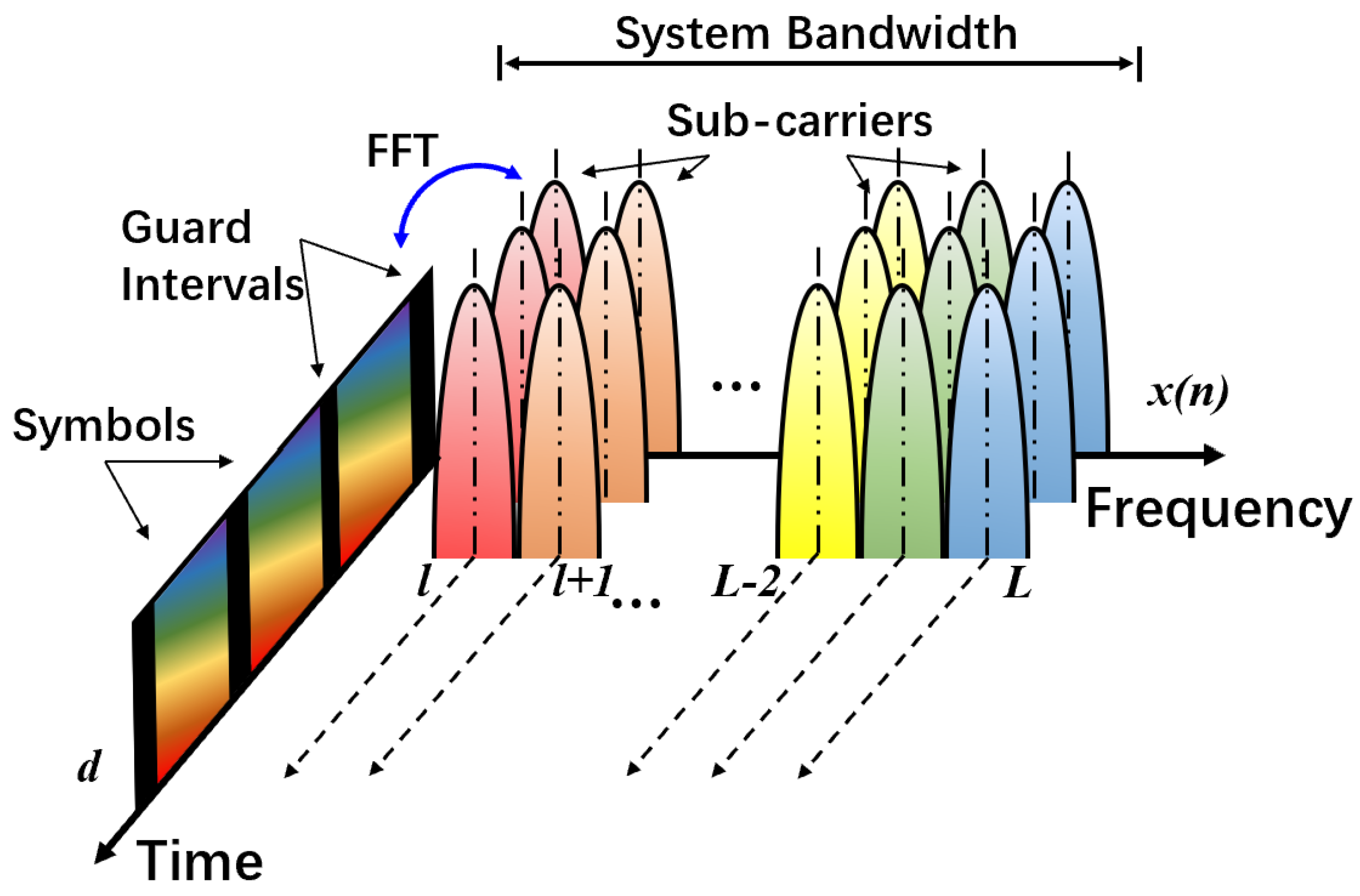

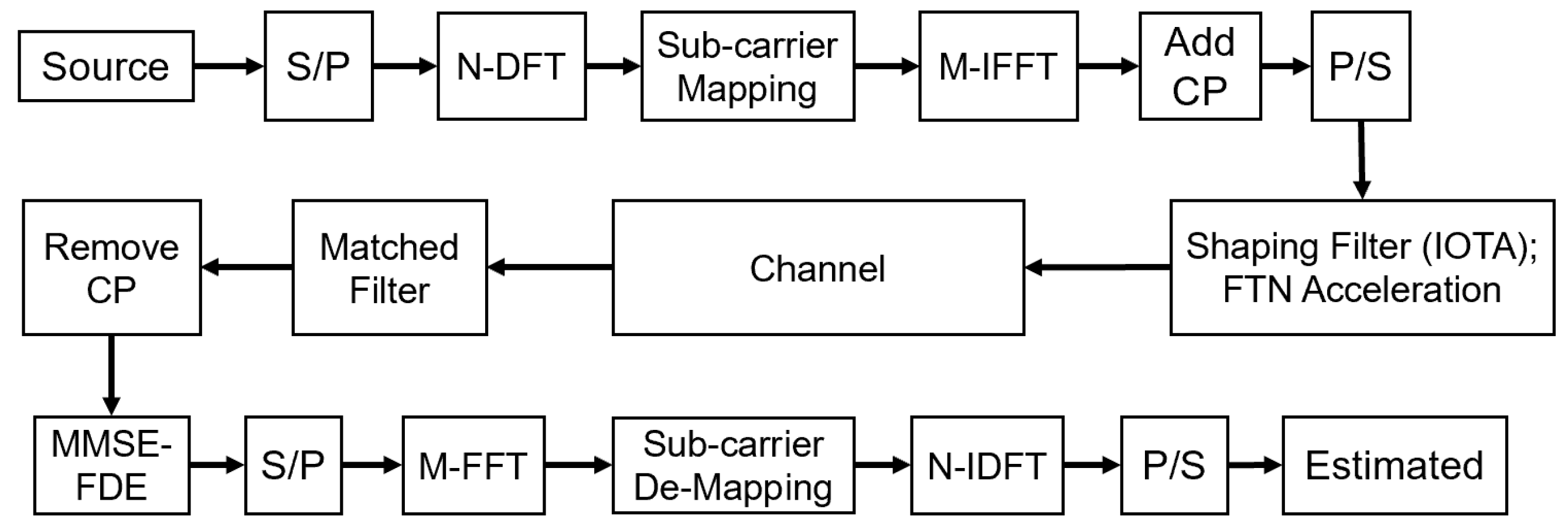

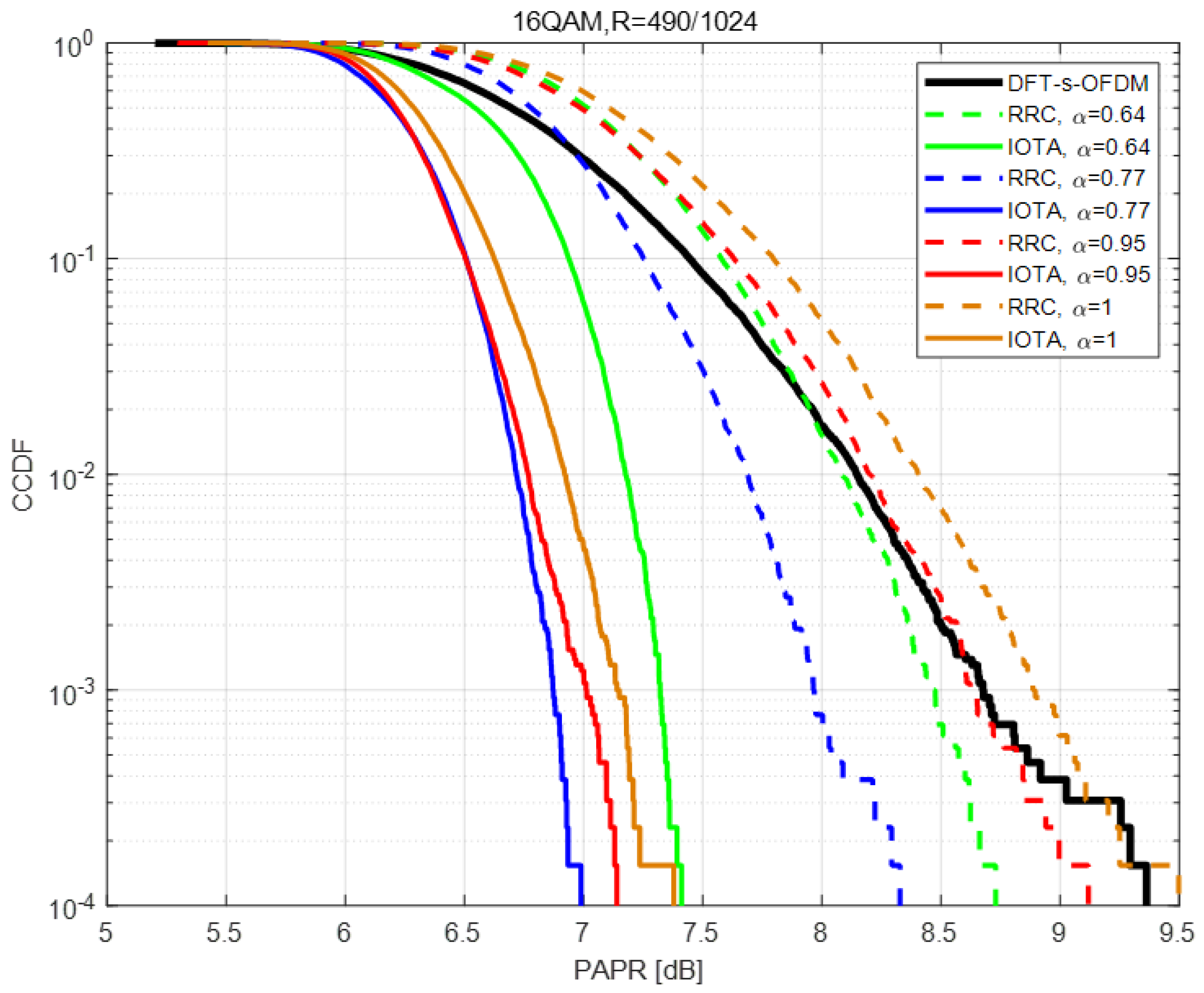
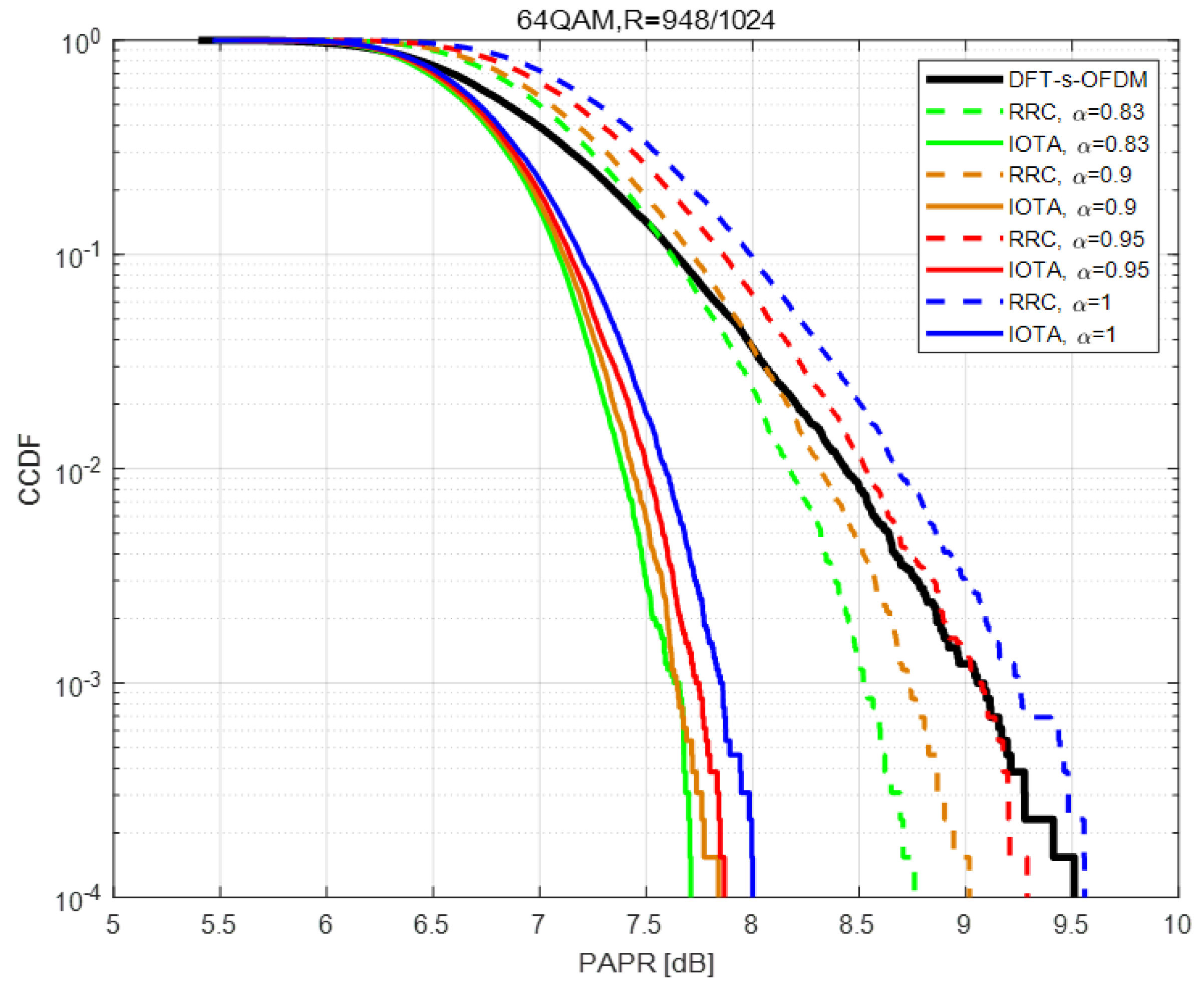
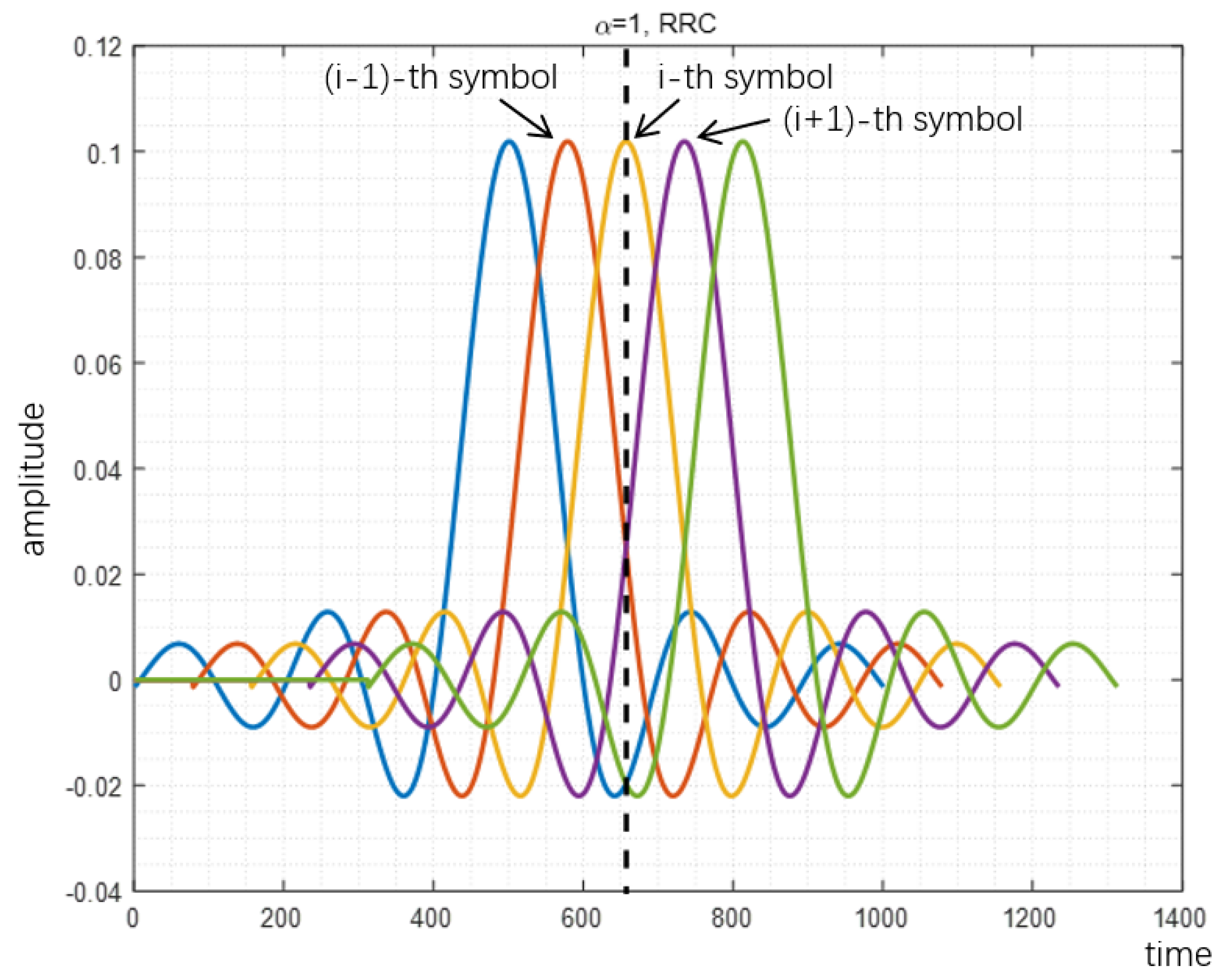




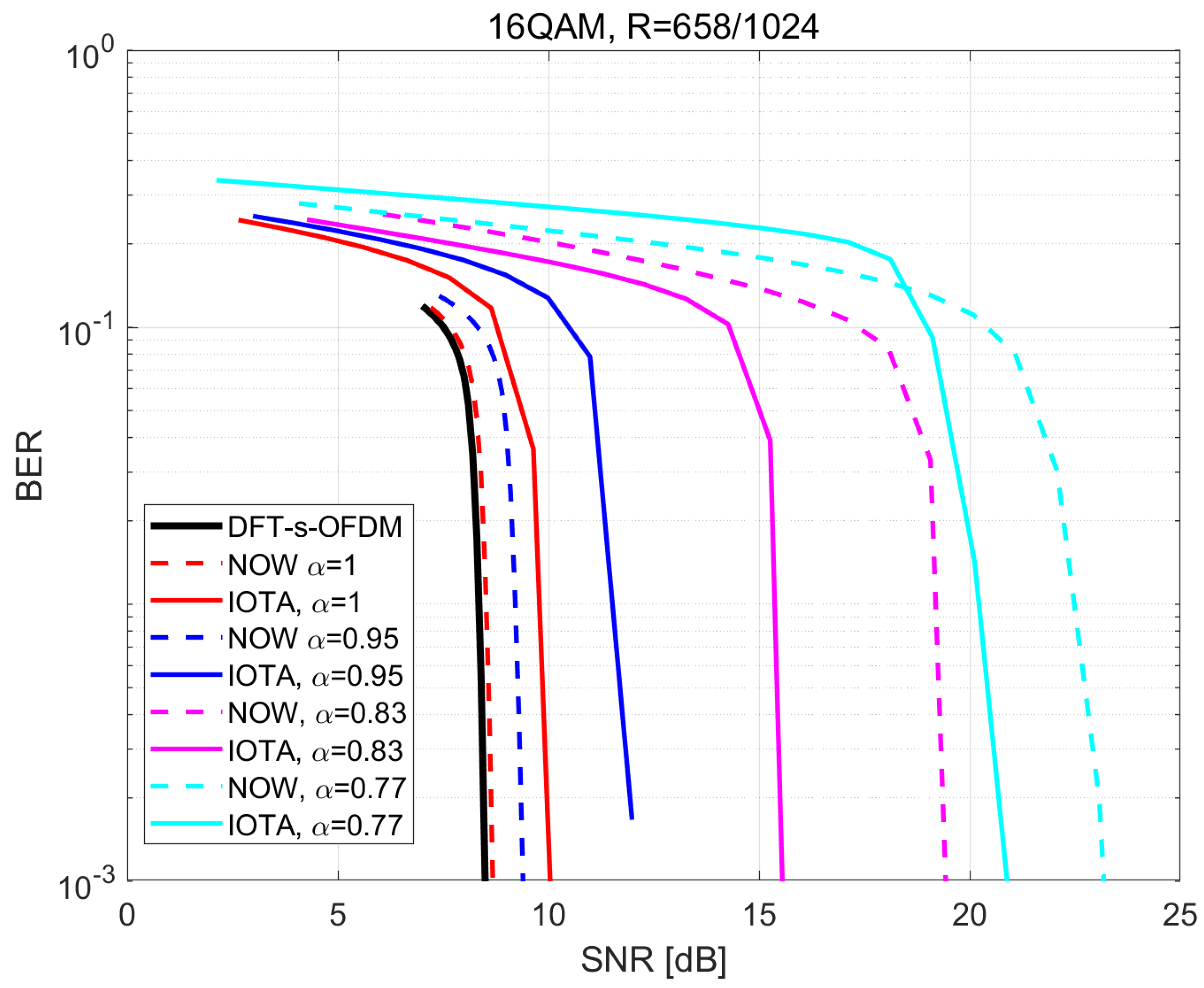
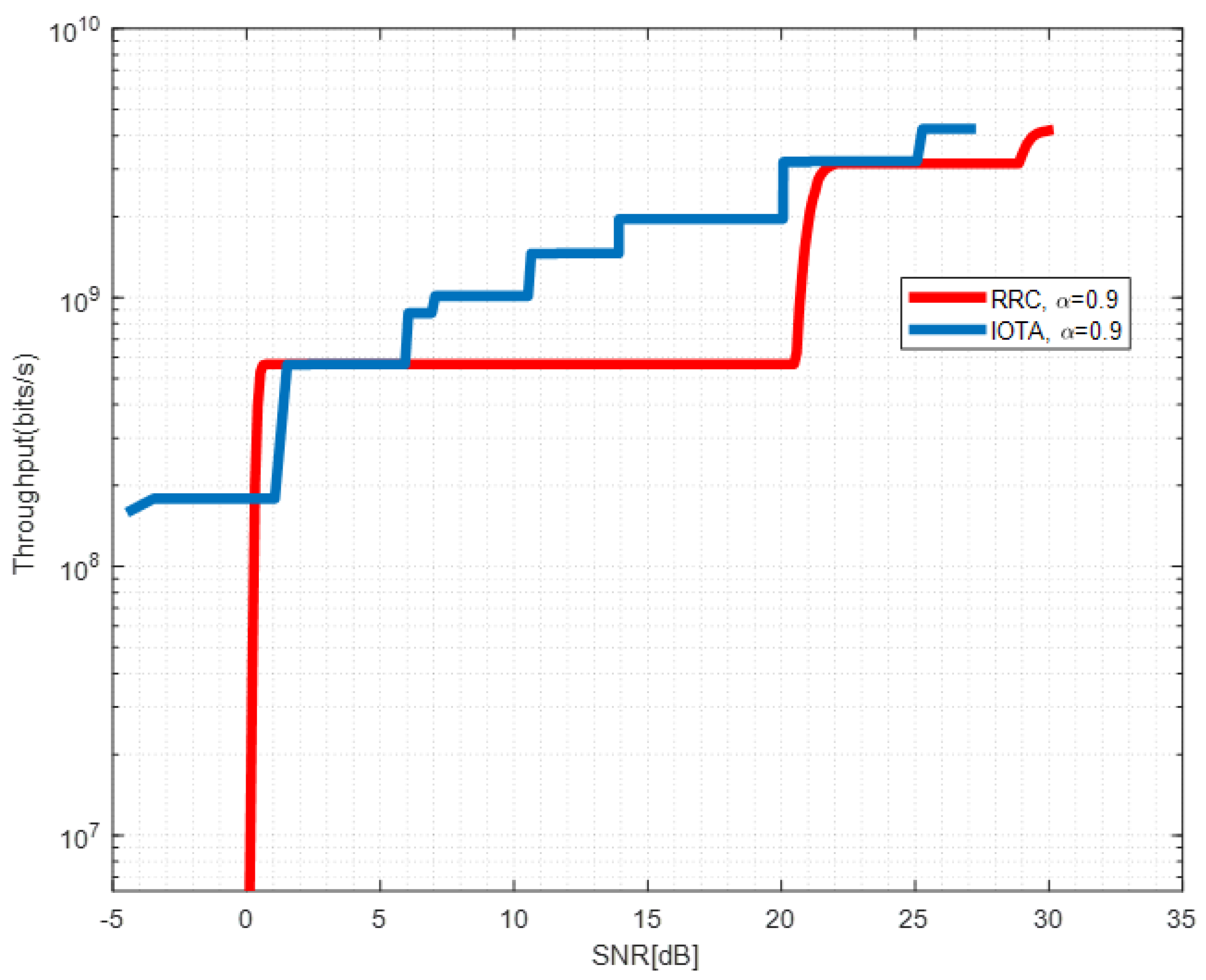

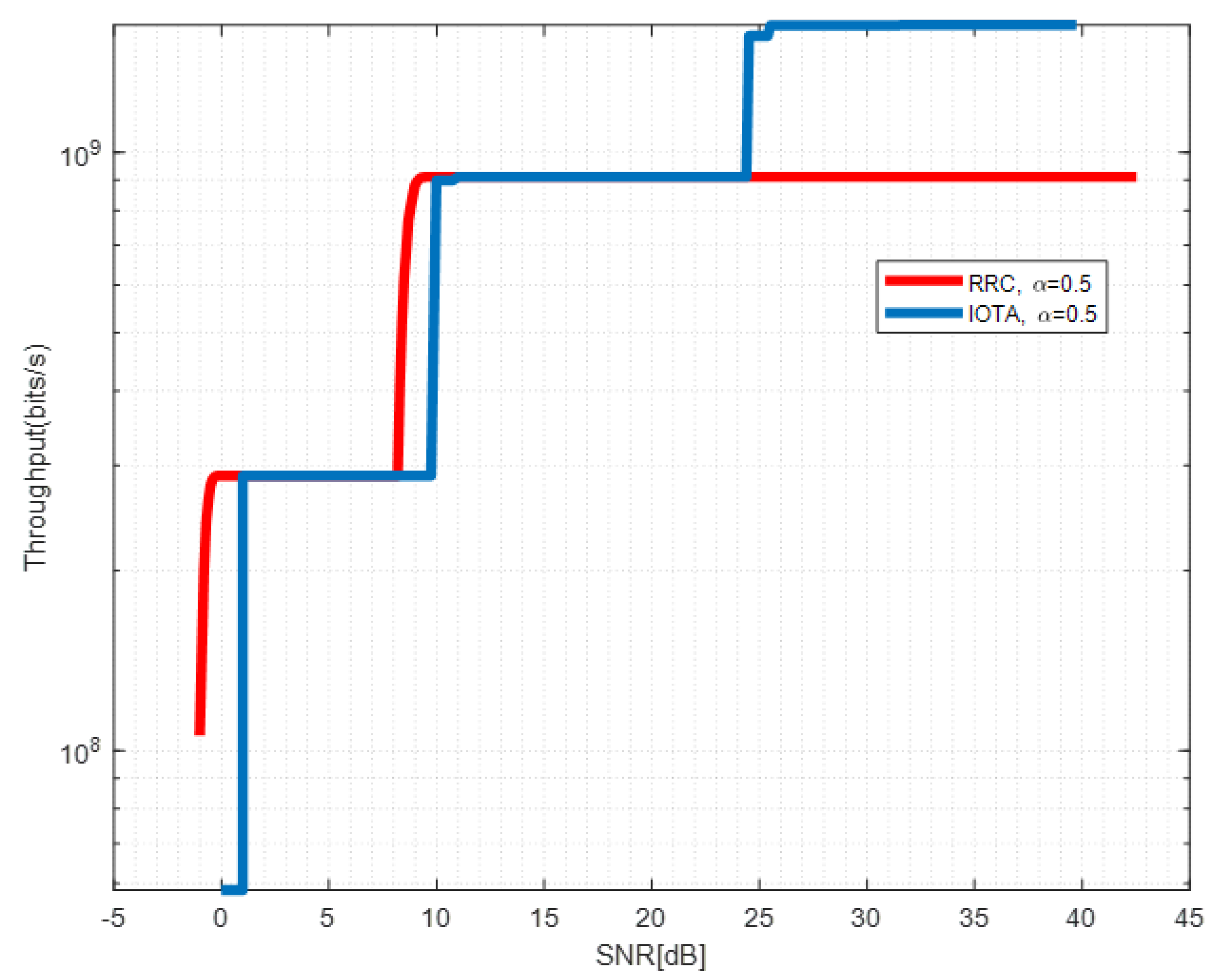
| Carrier Frequency | 70 GHz [33] |
| Subcarrier spacing (SCS) | kHz |
| Symbol Interval | |
| System bandwidth | 800 MHz |
| DFT size | 7792 |
| Guard band | 40 MHz |
| Allocated subcarriers | (DFT size) |
| FFT size | 1024 |
| Roll-off factor of RRC | |
| 20()/28()/30()/ | |
| RRC taps | 32()/34()/42()/ |
| 52()/68()/102() | |
| Up-sampling factor for signal | |
| Channel | AWGN |
| Channel coding | LDPC |
| Modulation | QPSK, 16QAM, 64QAM |
| Baseline Waveforms | DFT-s-OFDM/NOW [32] |
| MCS Index | Mod Order | R [/1024] | SE | Best -IOTA | Best -RRC | PAPR Gain over RRC /dB | PAPR Gain over DFT /dB |
|---|---|---|---|---|---|---|---|
| 0 | 2 | 120 | 0.2344 | 0.77 | 0.77 | 2 | 3.5 |
| 1 | 2 | 379 | 0.7402 | 0.77 | 0.77 | 2 | 3.5 |
| 2 | 2 | 679 | 1.3262 | 0.77 | 0.77 | 1.8 | 3.5 |
| 3 | 4 | 340 | 1.3281 | 0.83/0.9 | 0.77 | 1.6 | 2.6 |
| 4 | 4 | 490 | 1.9141 | 0.83 | 0.77 | 1.3 | 2.4 |
| 5 | 4 | 658 | 2.5703 | 0.83 | 0.83/0.77 | 1.5 | 2.5 |
| 6 | 6 | 438 | 2.5664 | 0.83 | 0.83/0.77 | 0.9 | 1.9 |
| 7 | 6 | 719 | 4.2129 | 0.83 | 0.83 | 1.3 | 1.7 |
| 8 | 6 | 948 | 5.5547 | 0.83 | 0.83 | 1.1 | 1.8 |
| MCS Index | Mod Order | R [/1024] | SE | Min -IOTA | Min -RRC | Throughput Gain |
|---|---|---|---|---|---|---|
| 0 | 2 | 120 | 0.2344 | 0.25 | 0.38 | 0.52 |
| 1 | 2 | 379 | 0.7402 | 0.38 | 0.5 | 0.32 |
| 2 | 2 | 679 | 1.3262 | 0.5 | 0.64 | 0.28 |
| 3 | 4 | 340 | 1.3281 | 0.5 | 0.64 | 0.28 |
| 4 | 4 | 490 | 1.9141 | 0.64 | 0.77 | 0.20 |
| 5 | 4 | 658 | 2.5703 | 0.64 | 0.83 | 0.30 |
| 6 | 6 | 438 | 2.5664 | 0.64 | 0.83 | 0.30 |
| 7 | 6 | 719 | 4.2129 | 0.77 | 0.9 | 0.17 |
| 8 | 6 | 948 | 5.5547 | 0.77 | 0.9 | 0.17 |
Publisher’s Note: MDPI stays neutral with regard to jurisdictional claims in published maps and institutional affiliations. |
© 2022 by the authors. Licensee MDPI, Basel, Switzerland. This article is an open access article distributed under the terms and conditions of the Creative Commons Attribution (CC BY) license (https://creativecommons.org/licenses/by/4.0/).
Share and Cite
Zhuo, X.; Pan, J.; Wang, H.; Li, X.; Ye, N. Enhancing PAPR and Throughput for DFT-s-OFDM System Using FTN and IOTA Filtering. Sensors 2022, 22, 4907. https://doi.org/10.3390/s22134907
Zhuo X, Pan J, Wang H, Li X, Ye N. Enhancing PAPR and Throughput for DFT-s-OFDM System Using FTN and IOTA Filtering. Sensors. 2022; 22(13):4907. https://doi.org/10.3390/s22134907
Chicago/Turabian StyleZhuo, Xinran, Jianxiong Pan, Huwei Wang, Xiangming Li, and Neng Ye. 2022. "Enhancing PAPR and Throughput for DFT-s-OFDM System Using FTN and IOTA Filtering" Sensors 22, no. 13: 4907. https://doi.org/10.3390/s22134907






